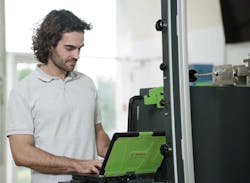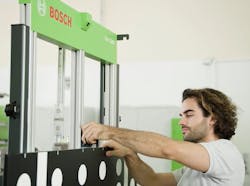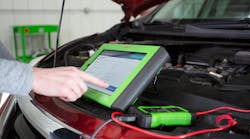Content brought to you by Motor Age. To subscribe, click here.
What you'll learn:
Whether or not a technician can service the ADAS itself can be the difference between making an additional service sale or having to outsource to another shop and losing that revenue.
While ADAS equipment is a large investment, there are recalibration systems available that are future-proofed and modular.
Technicians must think of how the repairs beyond ADAS affect the system.
A decade ago, it wasn’t especially common for technicians to encounter cars with advanced driver assistance systems (ADAS) in their shops. For many, learning how to repair and recalibrate ADAS was a distant concern for the future. That’s changed drastically in the years since. Nearly every new vehicle being manufactured and sold today has at least one form of ADAS or another. It’s no longer an option for people to add to their cars; it comes as part of the standard vehicle package. Given the state of ADAS, it’s time for technicians and shop owners to acknowledge that the future is here.
The ADAS advancements over the last decade, and especially the last five years, have had great advantages for driver safety. It’s why we’re seeing more and more ADAS in vehicles, and that number will only continue to grow. Features can be as simple as automatic braking systems or as complex as multi-camera and multi-sensor systems for automatic parking and self-driving. That said, these new technologies bring with them many new challenges for technicians. Since ADAS is currently not standardized across OEMs, or even across vehicles within the same OEM, technicians face several learning curves when it comes to dealing with ADAS.
Embracing training is of the utmost importance in this new landscape. The sooner technicians learn how to repair and recalibrate current ADAS on vehicles, the bigger the opportunity and advantage they will have going forward.
The necessity and opportunity of training
It’s completely understandable for technicians and shops to have some trepidation around learning new skillsets, especially when ADAS systems involve elements such as programming. It’s important to acknowledge, however, that ADAS isn’t going anywhere. It might seem like you can get away without training to diagnose, service, and calibrate ADAS, but that feeling won’t last. The bright side: Committing to training sooner offers shops and technicians an incredible amount of opportunity for revenue and service growth.
We used to see huge markets for ADAS services in major cities and along the coasts, since those were regions with larger numbers of high-end cars. But what was previously limited to high-end cars in metropolitan regions has spread across the country. ADAS is in every vehicle, from luxury cars like Mercedes and BMWs, to pickup trucks, like Ford’s F-150, to modest, affordable models from manufacturers like Hyundai. It does not matter where in the country a technician is located; they will have to work on cars with ADAS.
Take this scenario: A customer backs into something, breaking his or her taillight, and brings the car to the shop. In years past, a technician might take a look, replace the taillight, and the repair would be complete. Today, however, that broken taillight might affect a rearview camera that’s part of the vehicle’s ADAS. Now what happens? Does the technician take that job on, or will the shop have to subcontract that out to a different shop or dealership that knows the proper training and has the equipment to service the car’s ADAS?
Whether or not a technician can service the ADAS itself is the difference between making an additional service sale or having to outsource to another shop and losing that revenue.
Training is already the number one priority for anybody working in this industry. ADAS repair is especially critical, since it’s a specialized skillset that will continue to change as systems evolve. Technicians who can offer ADAS services today are at a great advantage. Not only do shops that offer ADAS calibration and repair see an increase in revenue from ADAS-specific requests, but their overall business can grow as they build trust with customers, who increasingly own ADAS-equipped vehicles.
Shops and technicians who invest in ADAS training earlier will have a leg up on the competition. And those technicians with ADAS expertise today will build a strong foundation for handling ADAS concerns of the future, allowing them to further develop their skills in step with evolving technologies.
Steps to take to start ADAS service
Let’s say you’re a technician or shop owner who’s convinced it’s time to get into ADAS repairs. Now the question is, where do you start? There are several factors to consider when it comes to training and adapting to ADAS servicing in general.
As noted, there’s not a lot of standardization across ADAS systems, and therefore, ADAS repairs. Different OEMs have different methods, target styles, and procedures. The first step a technician or shop needs to take is to get familiar with what kinds of ADAS are on the market. Do your research. Carefully consider what specific systems you might want to take on.
The next step is to get an understanding of the basics of ADAS. Say you plug the scan tool into a vehicle and particular codes come up that have to do with ADAS. A technician working on ADAS should be able to answer questions like: Is this something I can recalibrate dynamically via a road test, or does it have to be a static calibration in a facility with fixtures and targets? Do I need another piece of equipment? What piece of equipment would I need?
Most shops in North America can easily calibrate ADAS in domestic vehicles today. These, for the most part, only require a scan tool since they mainly rely on dynamic calibration. Repairs might be more complicated, but as far as calibration goes, there’s not much training required.
Moving into some of the Asian and European OEMs, calibrations and repairs become a bit more complicated. Mainly, these cars require more tools and space. Every manufacturer has a different target, and some have multiple targets, for calibration. When it comes to expanding ADAS services into these vehicles, shops must consider whether they have the appropriate amount of space. A large space may be needed to allow for the size of the vehicle, the calibration equipment and the clear area required by the OEM around both the vehicle and the equipment during calibration.
Next, shops must decide whether to invest in sophisticated recalibration systems and tools, with components such as vision sensors, radar reflectors, and surround view floor mat targets. These recalibration systems require additional training, as they must be set up at precise distances from the vehicle, taking into consideration the specific pitch, height, angle, and roll in relation to the vehicle’s targets. While this might sound daunting to take on, there are solutions that are intuitive and walk technicians through the process of precise positioning.
This equipment, however, does come with a high initial investment, costing upward of tens of thousands of dollars. It is likely one of the bigger decisions a technician or shop will make when it comes to their ADAS capabilities. While it is a large investment, there are recalibration systems available that are future-proofed and modular, ensuring that shops can affordably upgrade the existing equipment without having to buy an entirely new system as future ADAS technologies are introduced.
That said, technicians will want to get a grasp of making these simpler repairs and calibrations before getting into the full-blown ADAS. That’s where decisions around training come in. Technicians and shops will want to investigate training and certification options. You might consider training courses from manufacturers or aftermarket tool companies. Another option is to take ADAS courses from an independent trainer. In the last five years, more independent training companies have cropped up in response to ADAS service demand, and they’re amazing resources for technicians wanting to get into the field.
Once a technician is equipped with the knowledge and skills to repair ADAS, he or she can consider becoming certified to demonstrate their expertise. For example, the National Institute for Automotive Service Excellence (ASE) recently introduced an ADAS-specific specialist certification test. Technicians who pass the test are deemed qualified to diagnose, repair, and calibrate ADAS on automobiles, SUVs, and light-duty trucks.
Shops will need to consider what they can take on, and what opportunities make the most sense to their space and skillsets in this diversified landscape. With the right training and equipment, there’s definitely a great opportunity for investment-return.
Beyond ADAS
It’s worth mentioning that ADAS does not exist in a silo. Shops and technicians today need to understand that even the most basic repair that they have been doing for the last 20 years could affect a vehicle’s ADAS.
As technicians progress farther into learning about ADAS and making those repairs and calibrations, they also need to think holistically about the vehicle. Yes, training on specific systems from specific OEMs is great, but technicians must think of how the repairs beyond ADAS affect the system. For example, unhooking and replacing the battery affects the memory on computers, which in turn affects ADAS. Or a repair as basic as replacing the throttle body has an impact on ADAS.
This is a whole different way of looking at the question of whether to train for ADAS as a technician. There is a whole vehicle picture that is much larger than the system itself, which is even more reason to invest that time and energy into training.





